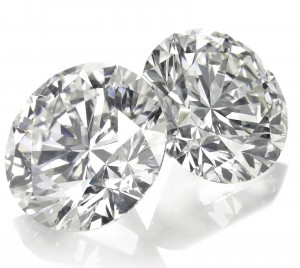Diamonds
 The reasons for buying a diamond are as diverse as the people who desire them.
The reasons for buying a diamond are as diverse as the people who desire them.
Diamonds are beautiful: Formed millions of years ago, they have stood the test of time with a fire and brilliance that is unquenchable. They create an aura of success and inspire feelings of pride.
Diamonds are durable: A diamond is the hardest natural substance known. They resist deterioration and you can be confident that the diamond you buy today will still shine as brilliantly when your great-grandchildren wear it.
Diamonds are rare: For every carat of rough diamonds recovered, more than 250 tonnes of ore have to be blasted, crushed and processed. Only 20% will be of gem quality.
Choosing a Diamond
Two diamonds may at first glance look alike, but the truth is that they are very different. Although they may be of equal size, they may have very unequal values.
There are four characteristics to understand that will help you when buying a diamond. They are known as the four C’s – cut, colour, clarity and carat weight. It is the combination of these four factors that determines the value of a diamond.
 Colour: Most gem diamonds seen alone appear white, but most have a hint of colour, mainly yellow. Diamonds with no trace of colour at all are extremely rare and the closer they are to no colour, the more rare and valuable they will be. Also rare are diamonds with a strong pure colour that are called “fancies” and which are very valuable. The Argyle Mine in Australia, which is the world’s biggest diamond mine, produces the rare pink diamonds as well as beautiful cognac and champagne coloured diamonds.
Colour: Most gem diamonds seen alone appear white, but most have a hint of colour, mainly yellow. Diamonds with no trace of colour at all are extremely rare and the closer they are to no colour, the more rare and valuable they will be. Also rare are diamonds with a strong pure colour that are called “fancies” and which are very valuable. The Argyle Mine in Australia, which is the world’s biggest diamond mine, produces the rare pink diamonds as well as beautiful cognac and champagne coloured diamonds.
Clarity: Diamonds were formed millions of years ago, deep within the earth under enormous heat and pressure. Consequently, most diamonds contain tiny marks, known as inclusions, which make each stone unique. The inclusions don’t necessarily weaken the stone and when they don’t interfere with the passage of light they do not affect its beauty. The fewer and smaller the inclusions, the more valuable a diamond will be.
Cut/make: How well it is cut determines a diamond’s brilliance. It is the skill of the cutter that unlocks the natural beauty of a diamond, revealing all of its hidden fire and brilliance. Most diamonds are cut with a full 58 facets and it is important that these are cut to precise angles. A diamond that is cut well will reflect light from one facet to another and then back out through the top of the diamond. Only a well-cut diamond will really sparkle.
Carat weight: A diamond’s weight is the simplest of its characteristics to measure and from the earliest times it was used to calculate a diamond’s value. Diamond weight is measured in carats, and each carat is divided into 100 points A carat is equal to one-fifth of a gram.
Birthstones
- January; Garnet
- February; Amethyst
- March; Aquamarine
- April; Diamond
- May; Emerald
- June; Pearl
- July; Ruby
- August; Peridot
- September; Sapphire
- October; Opal
- November; Topaz
- December; Turquoise
Rhodium Plating
Rhodium plating is a decorative surface often applied to precious metals such as white gold to give it a uniform and brighter finish and on silver to resist tarnish. The rhodium wears off over time, the wear being especially noticeable on jewellery in use every day, like wedding and engagement rings.
High-quality white gold (often coloured with platinum or palladium) retains a good whiteness in the base metal long after the rhodium plating has worn away. White gold coloured with a nickel mix has a yellowish white base colour and can require occasional maintenance to retain the white colouring.
Customers need to be aware of the on-going cost of maintaining their rhodium plated jewellery in pristine condition.

